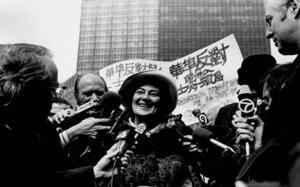Queen Esther and Bella Abzug: Costumes, Leadership, and Identity
Bella Abzug at a New York press conference in 1972.
Copyright © Diana Mara Henry, dianamarahenry.com
How did Queen Esther and Bella Abzug make change in their communities? What can their stories teach us about costumes and gender? In this online learning program, we examined how the biblical figure Esther and the historical figure Bella Abzug fought for justice and liberation by adopting personas that helped them to achieve their goals. Watch the recording to see examples of how to use the stories of these women in your classrooms as you prepare for Purim.
Session Recording
View the recording to listen in on our discussion on Purim, costumes, and gender and to see modeled close readings of primary sources.
Session Materials and Handouts
Lesson Links
- Lesson Plan: Queen Esther and Bella Abzug: Costumes, Leadership, and Identity from Go & Learn
Related Resources from the Jewish Women’s Archive
- Bella Abzug in JWA's Jewish Women: A Comprehensive Historical Encyclopedia
- Bella Abzug in JWA's Women of Valor exhibit.
- Allyson Mattanah's Twersky Award-winning Lesson Plan, “Who will you be? Esthers and Vashtis in the Labor Movement”
- Bella Abzug elected to congress in JWA's This Week in History
- Bess Myerson crowned first Jewish Miss America in JWA's This Week in History
Abzug, Esther, and Purim elsewhere on the web
- Complete Text of the Scroll of Esther in Hebrew and English from Sefaria.org
- The Whole Megillah (Almost) by Shoshana Silberman—suggested by Samara Sofian
- Megillat Esther: a Graphic Novel by JT Waldman—suggested by Marilyn Heiss
Ideas for expanding this lesson plan
- Marilyn Heiss and Lynn Anne Cutler both observed that this lesson would tie in well to discussions about the strict guidelines in the Torah for how high priests must dress, suggesting that it may help students better understand the relationship between how one dresses and one's role in society.
- Naomi Sandberg reminded us that Esther changed her name from the Hebrew “Hadassah” to the decidedly Persian “Esther.” On the other hand, Bess Myerson, the first Jewish woman to win Miss America, made the conscious decision to keep her Jewish name even after being told she’d likely be more successful if she did so. This could lead to another lesson on the relationship between names and identity.



